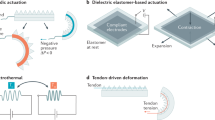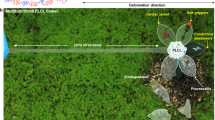Abstract
Self-healing materials are indispensable for soft actuators and robots that operate in dynamic and real-world environments, as these machines are vulnerable to mechanical damage. However, current self-healing materials have shortcomings that limit their practical application, such as low healing strength (below a megapascal) and long healing times (hours). Here, we introduce high-strength synthetic proteins that self-heal micro- and macro-scale mechanical damage within a second by local heating. These materials are optimized systematically to improve their hydrogen-bonded nanostructure and network morphology, with programmable healing properties (2–23 MPa strength after 1 s of healing) that surpass by several orders of magnitude those of other natural and synthetic soft materials. Such healing performance creates new opportunities for bioinspired materials design, and addresses current limitations in self-healing materials for soft robotics and personal protective equipment.
This is a preview of subscription content, access via your institution
Access options
Access Nature and 54 other Nature Portfolio journals
Get Nature+, our best-value online-access subscription
$29.99 / 30 days
cancel any time
Subscribe to this journal
Receive 12 print issues and online access
$259.00 per year
only $21.58 per issue
Buy this article
- Purchase on Springer Link
- Instant access to full article PDF
Prices may be subject to local taxes which are calculated during checkout




Similar content being viewed by others
References
Rus, D. & Tolley, M. T. Design, fabrication and control of soft robots. Nature 521, 467–475 (2015).
Hu, W., Lum, G. Z., Mastrangeli, M. & Sitti, M. Small-scale soft-bodied robot with multimodal locomotion. Nature 554, 81–85 (2018).
Ren, Z., Hu, W., Dong, X. & Sitti, M. Multi-functional soft-bodied jellyfish-like swimming. Nat. Commun. 10, 2703 (2019).
Martinez, R. V., Glavan, A. C., Keplinger, C., Oyetibo, A. I. & Whitesides, G. M. Soft actuators and robots that are resistant to mechanical damage. Adv. Funct. Mater. 24, 3003–3010 (2014).
Yang, G.-Z. et al. The grand challenges of Science Robotics. Sci. Robot. 3, eaar7650 (2018).
Blaiszik, B. J. et al. Self-healing polymers and composites. Annu. Rev. Mater. Res. 40, 179–211 (2010).
Terryn, S., Brancart, J., Lefeber, D., van Assche, G. & Vanderborght, B. Self-healing soft pneumatic robots. Sci. Robot. 2, eaan4268 (2017).
Canadell, J., Goossens, H. & Klumperman, B. Self-healing materials based on disulfide links. Macromolecules 44, 2536–2541 (2011).
Cordier, P., Tournilhac, F., Soulié-Ziakovic, C. & Leibler, L. Self-healing and thermoreversible rubber from supramolecular assembly. Nature 451, 977–980 (2008).
Chen, Y., Kushner, A. M., Williams, G. A. & Guan, Z. Multiphase design of autonomic self-healing thermoplastic elastomers. Nat. Chem. 4, 467–472 (2012).
Li, C.-H. et al. A highly stretchable autonomous self-healing elastomer. Nat. Chem. 8, 618–624 (2016).
Cao, Y. et al. A transparent, self‐healing, highly stretchable ionic conductor. Adv. Mater. 29, 1605099 (2017).
Urban, M. W. et al. Key-and-lock commodity self-healing copolymers. Science 362, 220–225 (2018).
Bilodeau, R. A. & Kramer, R. K. Self-healing and damage resilience for soft robotics: a review. Front. Robot. AI 4, 48 (2017).
Acome, E. et al. Hydraulically amplified self-healing electrostatic actuators with muscle-like performance. Science 359, 61–65 (2018).
Markvicka, E. J., Bartlett, M. D., Huang, X. & Majidi, C. An autonomously electrically self-healing liquid metal–elastomer composite for robust soft-matter robotics and electronics. Nat. Mater. 17, 618–624 (2018).
Tan, Y. J. et al. A transparent, self-healing and high-κ dielectric for low-field-emission stretchable optoelectronics. Nat. Mater. 19, 182–188 (2020).
Huynh, T.-P., Sonar, P. & Haick, H. Advanced materials for use in soft self‐healing devices. Adv. Mater. 29, 1604973 (2017).
Roberts, A. D. et al. Synthetic biology for fibers, adhesives, and active camouflage materials in protection and aerospace. MRS Commun. 9, 486–504 (2019).
Jung, H. et al. Molecular tandem repeat strategy for elucidating mechanical properties of high-strength proteins. Proc. Natl Acad. Sci. 113, 6478–6483 (2016).
Guerette, P. A. et al. Accelerating the design of biomimetic materials by integrating RNA-seq with proteomics and materials science. Nat. Biotechnol. 31, 908–915 (2013).
Nixon, M. & Dilly, P. N. Sucker surfaces and prey capture. Symp. Zool. Soc. Lond. 38, 447–511 (1977).
Pena-Francesch, A. & Demirel, M. C. Squid-inspired tandem repeat proteins: functional fibers and films. Front. Chem. 7, 69 (2019).
Pena-Francesch, A. et al. Mechanical properties of tandem-repeat proteins are governed by network defects. ACS Biomater. Sci. Eng. 4, 884–891 (2018).
Pena-Francesch, A. et al. Programmable proton conduction in stretchable and self-healing proteins. Chem. Mater. 30, 898–905 (2018).
Tomko, J. A. et al. Tunable thermal transport and reversible thermal conductivity switching in topologically networked bio-inspired materials. Nat. Nanotechnol. 13, 959–964 (2018).
Zhong, M., Wang, R., Kawamoto, K., Olsen, B. D. & Johnson, J. A. Quantifying the impact of molecular defects on polymer network elasticity. Science 353, 1264–1268 (2016).
Sariola, V. et al. Segmented molecular design of self-healing proteinaceous materials. Sci. Rep. 5, 13482 (2015).
Ding, D. et al. From soft self‐healing gels to stiff films in suckerin‐based materials through modulation of crosslink density and β‐sheet content. Adv. Mater. 27, 3953–3961 (2015).
Bier, J. M., Verbeek, C. J. R. & Lay, M. C. Thermal transitions and structural relaxations in protein‐based thermoplastics. Macromol. Mater. Eng. 299, 524–539 (2014).
Cebe, P. et al. Beating the heat - fast scanning melts silk beta sheet crystals. Sci. Rep. 3, 1130 (2013).
Cho, S. H., White, S. R. & Braun, P. V. Self‐healing polymer coatings. Adv. Mater. 21, 645–649 (2009).
White, S. R. et al. Autonomic healing of polymer composites. Nature 409, 794–797 (2001).
Hines, L., Petersen, K., Lum, G. Z. & Sitti, M. Soft actuators for small‐scale robotics. Adv. Mater. 29, 1603483 (2017).
Ilievski, F., Mazzeo, A. D., Shepherd, R. F., Chen, X. & Whitesides, G. M. Soft robotics for chemists. Angew. Chem. Int. Ed. 50, 1890–1895 (2011).
Song, S., Drotlef, D.-M., Majidi, C. & Sitti, M. Controllable load sharing for soft adhesive interfaces on three-dimensional surfaces. Proc. Natl Acad. Sci. 114, E4344–E4353 (2017).
Josie, H. et al. Soft manipulators and grippers: a review. Front. Robot. AI 3, 69 (2016).
Madden, J. D. W. et al. Artificial muscle technology: physical principles and naval prospects. IEEE J. Ocean. Eng. 29, 706–728 (2004).
Miriyev, A., Stack, K. & Lipson, H. Soft material for soft actuators. Nat. Commun. 8, 596 (2017).
Rich, S. I., Wood, R. J. & Majidi, C. Untethered soft robotics. Nat. Electron. 1, 102–112 (2018).
Baumgartner, M. et al. Resilient yet entirely degradable gelatin-based biogels for soft robots and electronics. Nat. Mater. https://doi.org/10.1038/s41563-020-0699-3 (2020).
Pena-Francesch, A., Giltinan, J. & Sitti, M. Multifunctional and biodegradable self-propelled protein motors. Nat. Commun. 10, 3188 (2019).
Pena-Francesch, A. et al. Materials fabrication from native and recombinant thermoplastic squid proteins. Adv. Funct. Mater. 24, 7401–7409 (2014).
Acknowledgements
The authors thank H. Shahsavan and P. Cabanach for helpful discussions. M.C.D. and H.J. thank staff members of Penn State MRI and Huck user facilities. A.P.-F. and M.S. were supported by the Max Planck Society. A.P.-F. was also funded by the Alexander von Humboldt Foundation and the German Federal Ministry for Education and Research. M.S. was also funded by the European Research Council (ERC) Advanced Grant SoMMoR project with grant no: 834531. M.C.D. and H.J. were supported by the United States Army Research Office (grant no. W911NF-16-1-0019 and W911NF-18-1-026) and the Huck Endowment of The Pennsylvania State University.
Author information
Authors and Affiliations
Contributions
A.P.-F., M.C.D., and M.S. conceived the project. A.P.-F. designed and performed the experiments, analysed the data, and wrote the manuscript. H.J. performed the protein expression and purification. All authors participated in manuscript revisions, discussions, and data interpretation.
Corresponding authors
Ethics declarations
Competing interests
A.P.-F. and M.C.D. have issued patents (US patent 9,663,658 and US patent 10,253,144), and H.J. and M.C.D. have issued patents (US patent 9,765,121, US patent 10,047,127, and US patent 10,246,493) on technology related to processes described in this article. All other authors have no competing interests.
Additional information
Publisher’s note Springer Nature remains neutral with regard to jurisdictional claims in published maps and institutional affiliations.
Supplementary information
Supplementary Information
Supplementary Note 1, Supplementary Figs. 1–20, Supplementary Videos 1–5, and Supplementary References
Supplementary Video 1
Heat-assisted healing of TRn11 proteins
Supplementary Video 2
Protein-based pneumatic soft actuator
Supplementary Video 3
Protein-based soft gripper
Supplementary Video 4
Protein-based artificial muscle
Supplementary Video 5
Degradation of protein-based actuators
Supplementary Data 1
Self-healing performance benchmark
Supplementary Data 2
Actuator benchmark
Source data
Source Data Fig. 1b
Unprocessed SDS-PAGE gel from Fig. 1b
Source Data Fig. 1d
Cohesion and network parameter of polypeptides for Fig. 1d
Source Data Fig. 4c
Soft actuator displacement and force output for Fig. 4c
Rights and permissions
About this article
Cite this article
Pena-Francesch, A., Jung, H., Demirel, M.C. et al. Biosynthetic self-healing materials for soft machines. Nat. Mater. 19, 1230–1235 (2020). https://doi.org/10.1038/s41563-020-0736-2
Received:
Accepted:
Published:
Issue Date:
DOI: https://doi.org/10.1038/s41563-020-0736-2
This article is cited by
-
Ultrafast underwater self-healing piezo-ionic elastomer via dynamic hydrophobic-hydrolytic domains
Nature Communications (2024)
-
Design and build of small-scale magnetic soft-bodied robots with multimodal locomotion
Nature Protocols (2024)
-
Domains of life sciences in spacefaring: what, where, and how to get involved
npj Microgravity (2024)
-
Aqueous spinning of robust, self-healable, and crack-resistant hydrogel microfibers enabled by hydrogen bond nanoconfinement
Nature Communications (2023)
-
Programmable nanocomposites of cellulose nanocrystals and zwitterionic hydrogels for soft robotics
Nature Communications (2023)



